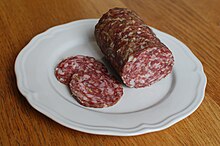| Revision as of 16:54, 10 May 2024 editJacktheBrown (talk | contribs)Extended confirmed users, Pending changes reviewers, Rollbackers76,793 edits Added "Commons category"Tags: Visual edit Mobile edit Mobile web edit Advanced mobile edit← Previous edit | Revision as of 16:12, 14 May 2024 edit undoJacktheBrown (talk | contribs)Extended confirmed users, Pending changes reviewers, Rollbackers76,793 editsNo edit summaryTags: Mobile edit Mobile web edit Advanced mobile editNext edit → | ||
| Line 1: | Line 1: | ||
| {{Short description|Italian pork and fennel salami}} | {{Short description|Italian pork and fennel salami}} | ||
| {{Italics title}} | {{Italics title}} | ||
| ] | ] | ||
| {{lang|it|'''Finocchiona'''}} ({{IPA-it|finokˈkjoːna|lang}}) is a ] variety, typical of ], ] area. It is characterized by the use of ]. | {{lang|it|'''Finocchiona'''}} ({{IPA-it|finokˈkjoːna|lang}}) is a ] variety, typical of ], ] area. It is characterized by the use of ]. | ||
Revision as of 16:12, 14 May 2024
Italian pork and fennel salami

Finocchiona (Italian: [finokˈkjoːna]) is a salami variety, typical of Tuscany, Florence area. It is characterized by the use of fennel.
Origins
Finocchiona originated in the Renaissance, and possibly even before, in the Late Middle Ages. The use of fennel was an alternative to pepper (a key ingredient of the standard salami), which was very expensive at the time, while fennel grew wild and abundant in the Tuscan countryside. Also, fennel is rich in menthol, and because of its anesthetic qualities, finocchiona was regularly offered by the winemakers of the Chianti area to their customers before tasting their lower quality wines to mask their taste. Its name derives from finocchio, the Italian name for fennel.
Preparation
Finocchiona's ingredients are chopped pork meat (generally cheek, shoulder, or belly), fennel seeds, red wine, salt, and pepper. It is fermented and then dried for not less than five months.
A variant, sbriciolona, is prepared with a coarser grind, and undergoes a shorter drying (not more than a month). This product has to be cut into larger slices than the typical finocchiona and is consumed using a fork and a knife because it tends to crumble.
See also
![]() Media related to Finocchiona at Wikimedia Commons
Media related to Finocchiona at Wikimedia Commons
References
- ^ Ruggero Larco. "La finocchiona". Accademia Italiana della Cucina (264). October 2014. pp.15–16.
- ^ Michael Ruhlman, Brian Polcyn (27 August 2012). Salumi: The Craft of Italian Dry Curing. W. W. Norton & Company, 2012. pp. 129–130. ISBN 978-0393084160.